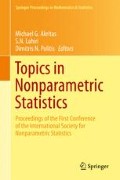Abstract
In many applications it is important to evaluate the impact of clusters of observations caused by the dependence and heaviness of tails in time series. We consider a stationary sequence of random variables {R n } n ≥ 1 with marginal cumulative distribution function F(x) and the extremal index θ ∈ [0, 1]. The clusters contain consecutive exceedances of the time series over a threshold u separated by return intervals with consecutive non-exceedances. We derive geometric forms of asymptotically equal distributions of the normalized cluster and inter-cluster sizes that depend on θ. The inter-cluster size determines the number T 1(u) of inter-arrival times between observations of the process R t arising between two consecutive clusters. The cluster size is equal to the number T 2(u) of inter-arrival times within clusters. The inferences are valid when u is taken as a sufficiently high quantile of the process {R n }. The derived geometric models allow us to obtain the asymptotically equal mean of T 2(u) and other indices of clusters. Applications in telecommunication networks are discussed.
Access this chapter
Tax calculation will be finalised at checkout
Purchases are for personal use only
Notes
- 1.
D(u n ) is satisfied if for any \(A \in \mathcal{I}_{1,l}(u_{n})\) and \(B \in \mathcal{I}_{l+s,n}(u_{n})\), where \(\mathcal{I}_{j,l}(u_{n})\) is the set of all intersections of the events of the form {R i ≤ u n } for j ≤ i ≤ l, and for some positive integer sequence {s n } such that s n = o(n), \(\vert P\{(A\bigcap B)\} - P\{A\}P\{B\}\vert \leq \alpha (n,s)\) holds and α(n, s n ) → 0 as n → ∞.
- 2.
The D ′ ′(u n )-condition [3, 6] states that if the stationary sequence {R t } satisfies the D(u n )-condition with \(u_{n} = a_{n}x + b_{n}\) and normalizing sequences a n > 0 and b n ∈ R such that for all x there exists μ ∈ R, σ > 0 and ξ ∈ R, such that
$$\displaystyle{n\left (1 - F(a_{n}x + b_{n})\right ) \rightarrow \left (1 + \frac{\xi (x-\mu )} {\sigma } \right )_{+}^{-1/\xi },\qquad \text{as}\qquad n \rightarrow \infty,}$$holds, where \((x)_{+} =\max (x, 0)\), then \(\lim _{n\rightarrow \infty }\sum _{j=2}^{r_{n}}P\{R_{j} \leq u_{n} < R_{j+1}\vert R_{1} > u_{n}\} = 0\), where r n = o(n), s n = o(n), α(n, s n ) → 0, (n∕r n )α(n, s n ) → 0 and s n ∕r n → 0 as n → ∞.
References
Araújo Santos, P., Fraga Alves, M.I.: A new class of independence tests for interval forecasts evaluation. Comput. Stat. Data Anal. 56(11), 3366–3380 (2012)
Beirlant, J., Goegebeur, Y., Teugels, J., Segers, J.: Statistics of Extremes: Theory and Applications. Wiley, Chichester, West Sussex (2004)
Chernick, M.R., Hsing, T., McCormick, W.P.: Calculating the extremal index for a class of stationary sequences. Adv. Appl. Prob. 23, 835–850 (1991)
Ferro, C.A.T., Segers, J.: Inference for clusters of extreme values. J. R. Statist. Soc. B. 65, 545–556 (2003)
Hsing, T., Huesler, J., Leadbetter, M.R.: On the exceedance point process for a stationary sequence. Prob. Theory Relat. Fields. 78, 97–112 (1988)
Leadbetter, M.R., Nandagopalan, L.: On exceedance point processes for stationary sequences under mild oscillation restrictions. Lect. Notes Stat. 51, 69–80 (1989)
Leadbetter, M.R., Lingren, G., Rootzén, H.: Extremes and Related Properties of Random Sequence and Processes, chap. 3. Springer, New York (1983)
Markovich, N.: Quality assessment of the packet transport of peer-to-peer video traffic in high-speed networks. Perform. Eval. 70, 28–44 (2013)
Markovich, N.: Modeling clusters of extreme values. Extremes 17(1), 97–125 (2014)
Markovich, N.M., Krieger, U.R.: Statistical Analysis and modeling of peer-to-peer multimedia traffic. In: Performance Handbook Next Generation Internet: Performance Evaluation and Applications. Lecture Notes in Computer Science, vol. 5233. Springer, Berlin (2010)
Markovich, N.M., Krieger, U.R.: Analyzing measurements from data with underlying dependences and heavy-tailed distributions. In: 2nd ACM/SPEC International Conference on Performance Engineering (ICPE 2011), Karlsruhe, 14–16 March 2011, pp. 425–436 (tutorial)
Robinson, M.E., Tawn, J.A.: Extremal analysis of processes sampled at different frequencies. J. R. Stat. Soc. B. 62(1), 117–135 (2000). doi:10.1111/1467-9868.00223
Süveges, M.: Likelihood estimation of the extremal index. Extremes 10, 41–55 (2007)
Acknowledgements
This work was supported in part by the Russian Foundation for Basic Research, grant 13-08-00744 A.
Author information
Authors and Affiliations
Corresponding author
Editor information
Editors and Affiliations
Rights and permissions
Copyright information
© 2014 Springer Science+Business Media New York
About this paper
Cite this paper
Markovich, N. (2014). Distributions of Clusters of Exceedances and Their Applications in Telecommunication Networks. In: Akritas, M., Lahiri, S., Politis, D. (eds) Topics in Nonparametric Statistics. Springer Proceedings in Mathematics & Statistics, vol 74. Springer, New York, NY. https://doi.org/10.1007/978-1-4939-0569-0_15
Download citation
DOI: https://doi.org/10.1007/978-1-4939-0569-0_15
Published:
Publisher Name: Springer, New York, NY
Print ISBN: 978-1-4939-0568-3
Online ISBN: 978-1-4939-0569-0
eBook Packages: Mathematics and StatisticsMathematics and Statistics (R0)

